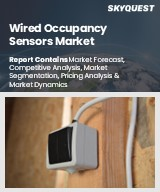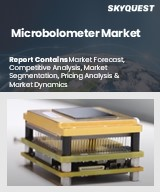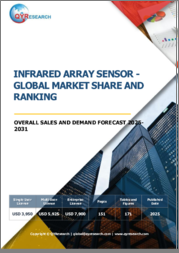
|
시장보고서
상품코드
1425132
비분산형 적외선(NDIR) 센싱 시장 : 예측(2024-2029년)Non-Dispersive Infrared Sensing Market - Forecasts from 2024 to 2029 |
||||||
NDIR(비분산형 적외선) 센싱 시장은 예측 기간 중 6.84%의 CAGR로 성장할 것으로 예측됩니다.
NDIR(비분산 적외선) 센싱은 가스 감지 분야에서 매우 중요한 기술로 각광받고 있으며, 분광학 원리를 활용하여 놀라운 정확도를 달성하기 위해 분광학 원리를 활용하고 있습니다. 대신 광대역 램프 광원과 스펙트럼 영역의 좁은 대역을 정밀하게 감지하도록 세심하게 설계된 광학 필터를 갖춘 컴포넌트의 영리한 상호 작용에 의존합니다. NDIR 센서의 핵심은 적외선(IR) 광원, 샘플 챔버 또는 라이트 튜브, 전용 광학 필터, 고감도 적외선 검출기 등 필수 요소로 구성되어 있으며, 이 선택된 대역은 조사하고자 하는 특정 가스의 흡수 특성과 전략적으로 일치합니다.
적외선은 광원에서부터 검출기까지 흔들림 없는 정확도로 경로를 따라 이동합니다. 동시에 대상 가스가 없는 기준 챔버가 기준선 역할을 하여 비교 분석을 용이하게 하여 측정 정확도를 높입니다. 열적 배경 신호의 영향을 상쇄하기 위해 IR 신호는 일반적으로 절단 또는 변조됩니다.
소개
NDIR(비분산형 적외선) 센싱 시장은 다양한 산업 분야에 적용 가능한 다목적성을 강조하는 여러 가지 요인으로 인해 예측 가능한 미래에 큰 성장을 이룰 것으로 보입니다. 가스 감지기로 잘 알려진 분광 센서인 NDIR 기술은 다양한 분야에서 필수적인 요소로 자리 잡았으며, NDIR 시장 확대의 주요 요인 중 하나는 특히 식품 가공 및 저장 산업에서 NDIR CO2 센서에 대한 수요가 급증하고 있다는 점입니다.을 보장하는 중요한 역할을 수행한다는 점이 이 분야에서의 채택을 촉진하고 있습니다. 또한 다양한 산업 분야에서 노동 안전에 대한 관심이 높아지면서 NDIR 센서에 대한 수요가 더욱 증가하고 있습니다. 가스 모니터링 및 감지에 적용되어 안전한 작업 환경을 보장하는 데 필수적인 역할을 하고 있습니다.
NDIR 센서는 가스 분석 및 감지뿐만 아니라 모니터링 시스템 및 난방, 환기 및 공조(HVAC) 장비에도 유용합니다. NDIR 센서는 식품 가공 및 저장, 화학, 의료, 석유 및 가스 등 다양한 산업 분야에 적용되고 있으며, NDIR 시장은 센서의 설계 및 기능에서 예상되는 기술 발전으로 인해 지속적으로 성장할 것으로 예상됩니다. 제조업체들은 기술 혁신의 최전선에 서서 독특한 제품을 개발하기 위해 인수 및 합병에 적극적으로 나서고 있습니다. 이러한 전략적 접근은 진화하는 업계의 요구에 부응하고 최첨단 솔루션이 요구되는 시장에서 경쟁력을 유지하기 위한 것입니다. 그 결과, NDIR 시장은 현재 적용 분야가 확대되고 있을 뿐만 아니라, 성능 향상과 다양한 기능을 약속하는 진보를 통해 진화할 준비가 되어 있습니다.
촉진요인
- 혁신적 기술 채택: NDIR 시장의 주요 제조업체들은 혁신적인 기술을 채택하고 있으며, 이는 시장 성장의 원동력이 되고 있습니다. 이러한 혁신적 기술 채택은 NDIR 센서의 성능과 효율성을 향상시켜 다양한 용도에서 더욱 매력적으로 만들어 줍니다.
- 정부 R&D 투자: R&D에 대한 정부 투자는 NDIR 시장을 촉진하는 데 중요한 역할을 합니다. 이러한 투자는 NDIR 센서 기술의 발전에 기여하여 성능, 신뢰성 및 비용 효율성을 향상시킬 수 있습니다.
- 지속가능성에 대한 중요성 증가: 업계 전반에 걸쳐 지속가능성에 대한 관심이 높아지면서 NDIR 센서에 대한 수요가 증가하고 있습니다. 조직과 산업계가 환경 발자국을 줄이는 데 집중하면서 NDIR 센서와 같은 정확하고 신뢰할 수 있는 가스 감지 및 모니터링 시스템에 대한 요구가 증가하고 있습니다.
- 다양한 용도의 가스 센서 수요 증가: 산업 안전, 환경 보호, 의료, 주거, 상업, 전력, 자동차, 연구 기관 등의 용도에서 가스 센서에 대한 수요 증가는 NDIR 시장의 주요 촉진요인입니다.
- 엄격한 근로자 보호 및 안전 규범: 특히 일본, 한국, 미국, 독일, 영국 등의 국가에서는 정부 규제와 엄격한 근로자 보호 및 안전 규범이 NDIR 시장 성장에 기여하고 있습니다. 이러한 규제는 직장 안전과 규정 준수를 보장하기 위해 NDIR 센서를 포함한 첨단 가스 감지 기술의 채택을 촉진하고 있습니다.
주요 기업에서 제공하는 제품
- Winsen이 제공하는 MH-Z19C CO2 센서는 공기 중 이산화탄소(CO2) 농도를 측정하는 비분산형 적외선(NDIR) 센서입니다.
- NENVITECH의 NDIR 센서는 다양한 가스의 농도를 측정하는 신뢰할 수 있고 비용 효율적인 방법입니다. 실내 공기질 모니터링, 산업 자동화, 의료기기, 환경 모니터링 등 다양한 용도에 적합합니다.
NDIR(비분산형 적외선) 센싱 시장내 산업 및 제조 분야의 괄목할 만한 성장:
NDIR(비분산형 적외선) 센싱 시장은 특히 역동적인 산업 및 제조 분야가 주도하는 강력한 성장세를 보이고 있으며, NDIR 센서는 가스 감지 및 모니터링 용도에서 매우 중요한 역할을 수행하며 이 분야에서 필수적인 요소로 자리 잡았습니다. 첨단 대기 오염 방지 시스템에 대한 수요 증가는 이 분야의 NDIR 시장 성장의 주요 원동력이 되고 있습니다. 끊임없는 기술 발전으로 인해 다양한 유해 가스가 대기 중으로 방출되어 지구 온난화라는 종합적인 우려의 원인이 되고 있습니다. 그 결과, NDIR 시장은 종합적인 대기질 관리 전략의 중요한 컴포넌트로서 산업 및 제조 부문에서 견인력을 얻고 있습니다.
산업 환경에서 NDIR 센서는 화학 산업에서 독성 가스를 감지하는 데 널리 적용되고 있습니다. 이 용도는 가스 누출의 위험을 최소화하고 직장 안전을 보장하며 직원의 복지를 보호하는 데 도움이 되는 것으로 입증되었습니다. 직장 안전에 대한 규제기관의 엄격한 지침이 강화됨에 따라 산업 및 제조 부문에서 NDIR 분석기에 대한 수요가 더욱 증가하고 있습니다. 이러한 규제는 산업계가 컴플라이언스 기준을 충족하고 안전 프로토콜을 강화하기 위해 첨단 감지 기술을 채택하도록 유도하고 있습니다.
북미가 NDIR(비분산형 적외선) 센싱 시장에서 큰 비중을 차지할 것으로 예상 :
북미 비분산형 적외선(NDIR) 센싱 시장은 여러 가지 요인이 복합적으로 작용하여 업계 선두 자리를 굳건히 하고 있으며, 큰 폭의 성장과 주목을 받을 준비가 되어 있습니다. 이러한 성장세를 지원하는 중요한 원동력은 미국, 캐나다 등의 규제기관이 시행하는 엄격한 근로자 보호 및 안전 규정을 준수하는 것입니다. 이러한 엄격한 규제로 인해 산업계는 최첨단 가스 감지 기술을 채택할 수밖에 없었고, NDIR 센서는 직장 안전과 규정 준수를 보장하기 위해 선호되는 옵션으로 부상하고 있습니다.
또한 이 지역의 지속가능성과 환경 보호에 대한 확고한 노력은 정밀하고 신뢰할 수 있는 가스 감지 및 모니터링 시스템에 대한 수요 증가로 이어져 NDIR 시장에 더욱 박차를 가하고 있습니다. 지속가능성에 대한 관심이 높아짐에 따라 환경 문제를 해결하기 위해 첨단 센서 기술의 필요성이 가장 중요하게 대두되고 있습니다. 특히 북미의 산업 및 제조 부문은 우수한 대기 오염 방지 시스템을 적극적으로 우선순위에 두고 있습니다. 이러한 목표를 달성하기 위해 NDIR 센서의 가스 감지 용도에 대한 채택이 증가하고 있으며, 이 기술이 대기질 관리 노력을 강화하는 데 있으며, 매우 중요한 역할을 하고 있음이 밝혀지고 있습니다.
목차
제1장 서론
- 시장 개요
- 시장의 정의
- 조사 범위
- 시장 세분화
- 통화
- 전제조건
- 기준년과 예측년 타임라인
제2장 조사 방법
- 조사 데이터
- 조사 프로세스
제3장 주요 요약
- 조사 하이라이트
제4장 시장 역학
- 시장 촉진요인
- 시장 억제요인
- Porter's Five Forces 분석
- 업계 밸류체인 분석
제5장 NDIR(비분산형 적외선) 센싱 시장 : 가스 유형별
- 서론
- 이산화탄소
- 탄화수소
- 일산화탄소
- 에틸렌
- 마취 가스
- 기타
제6장 NDIR(비분산형 적외선) 센싱 시장 : 용도별
- 서론
- 공조 설비
- 모니터링
- 탐지와 분석
제7장 NDIR(비분산형 적외선) 센싱 시장 : 최종사용자별
- 서론
- 자동차
- 화학제품
- 석유 및 가스
- 의료
- 산업 및 제조업
- 식품 가공과 보관
- 기타
제8장 NDIR(비분산형 적외선) 센싱 시장 : 지역별
- 서론
- 북미
- 미국
- 캐나다
- 멕시코
- 남미
- 브라질
- 아르헨티나
- 기타
- 유럽
- 영국
- 독일
- 프랑스
- 스페인
- 기타
- 중동 및 아프리카
- 사우디아라비아
- 아랍에미리트
- 이스라엘
- 기타
- 아시아태평양
- 일본
- 중국
- 인도
- 한국
- 인도네시아
- 태국
- 기타
제9장 경쟁 환경과 분석
- 주요 기업과 전략 분석
- 시장 점유율 분석
- 합병, 인수, 합의 및 협업
제10장 기업 개요
- Amphenol
- Honeywell International Inc.
- Senseair AB
- S+S Regeltechnik GmbH
- MIPEX TECHNOLOGY
- Nano Environmental Technology S.r.l.(N.E.T.)
- Zhengzhou Winsen Electronics Technology Co., Ltd.
The non-dispersive infrared sensing (NDIR) market is estimated to grow at a CAGR of 6.84% during the forecast period.
Non-Dispersive Infrared Sensing (NDIR) stands out as a pivotal technology in the realm of gas detection, leveraging spectroscopic principles to achieve remarkable precision. Unlike its dispersive counterparts, NDIR sensors eschew the use of dispersive elements such as prisms or diffraction gratings. Instead, they rely on a clever interplay of components, featuring a broadband lamp source and an optical filter meticulously designed to pinpoint a narrow band within the spectral region. This chosen band aligns strategically with the absorption characteristics of the specific gas under scrutiny. At the heart of an NDIR sensor lies an ensemble of essential elements, including an infrared (IR) source, a sample chamber or light tube, a dedicated light filter, and a highly sensitive infrared detector.
With unwavering precision, the IR light navigates its path from the source to the detector. Simultaneously, a reference chamber devoid of the target gas serves as a baseline, facilitating a comparative analysis that enhances the accuracy of the measurements. To counteract the influence of thermal background signals, the IR signal is commonly subjected to chopping or modulation, a technique that effectively isolates the desired signal from unwanted noise.
Introduction:
The Non-Dispersive Infrared Sensing (NDIR) market is poised for significant growth in the foreseeable future, driven by various factors that underscore its versatility and applicability across diverse industries. As a spectroscopic sensor renowned for its utility as a gas detector, NDIR technology has become an integral component in multiple sectors. One of the primary drivers behind the expanding NDIR market is the surging demand for NDIR CO2 sensors, particularly in the food processing and storage industry. The critical role played by NDIR sensors in maintaining optimal conditions for perishable goods, thereby ensuring their quality and safety, has fueled their adoption in this sector. Moreover, the increasing emphasis on occupational safety across various industries has further propelled the demand for NDIR sensors. Their application in monitoring and detecting gases makes them indispensable for ensuring a secure working environment.
NDIR sensors find utility not only in gas analysis and detection but also in monitoring systems and Heating, Ventilation, and Air Conditioning (HVAC) units. These sensors are deployed across a spectrum of industry verticals, including but not limited to food processing and storage, chemicals, medical, and oil and gas. The NDIR market is expected to witness continued growth owing to anticipated technological advancements in sensor design and functionality. Manufacturers in the NDIR space are actively engaging in acquisitions and mergers to stay at the forefront of innovation and develop unique products. This strategic approach is aimed at addressing evolving industry needs and staying competitive in a market that demands cutting-edge solutions. As a result, the NDIR market is not only expanding due to its current applications but is also poised for evolution through advancements that promise enhanced performance and broader capabilities.
Drivers:
- Adoption of Innovative Technologies: Major manufacturers in the NDIR market are embracing innovative technologies, which is driving market growth. This adoption of innovative technologies is enhancing the capabilities and efficiency of NDIR sensors, making them more attractive for various applications.
- Government Investments in Research and Development: Government investments in research and development are playing a significant role in propelling the NDIR market. These investments contribute to the advancement of NDIR sensor technologies, leading to improved performance, reliability, and cost-effectiveness.
- Growing Emphasis on Sustainability: There is a growing emphasis on sustainability across industries, which is driving the demand for NDIR sensors. As organizations and industries focus on reducing their environmental footprint, the need for accurate and reliable gas detection and monitoring systems, such as NDIR sensors, is increasing.
- Rising Demand for Gas Sensors in Various Applications: The increasing demand for gas sensors in applications such as industrial safety, environmental protection, medical, residential, and commercial, power, automobile, and research institutions is a key driver for the NDIR market. This demand is being fueled by the need to ensure safety, environmental compliance, and efficient operations in these diverse sectors.
- Stringent Worker Protection and Safety Norms: Government regulations and strict worker protection and safety norms, especially in countries like Japan, Korea, the USA, Germany, and the United Kingdom, are contributing to the growth of the NDIR market. These regulations are driving the adoption of advanced gas sensing technologies, including NDIR sensors, to ensure workplace safety and compliance.
Products offered by key companies:
- Winsen offers the MH-Z19C CO2 sensor is a non-dispersive infrared (NDIR) sensor that measures carbon dioxide (CO2) levels in the air. It is a popular choice for a variety of applications, including indoor air quality monitoring, HVAC control, and industrial automation.
- NENVITECH's NDIR sensors are a reliable and cost-effective way to measure the concentration of a variety of gases. They are ideal for a wide range of applications, including indoor air quality monitoring, industrial automation, medical devices, and environmental monitoring.
Prominent growth in the industrial and manufacturing segment within the non-dispersive infrared sensing market:
The Non-Dispersive Infrared Sensing (NDIR) market is experiencing robust expansion, particularly driven by the dynamic Industrial and manufacturing segment. NDIR sensors have become integral in this sector, playing a pivotal role in gas detection and monitoring applications. The escalating need for advanced air pollution control systems is a key catalyst for the growth observed in the NDIR market within this domain. The continual technological advancements have resulted in the emission of various hazardous gases into the atmosphere, contributing to the overarching concern of global warming. Consequently, the NDIR market is gaining traction in the industrial and manufacturing sectors as a crucial component of comprehensive air quality management strategies.
Within industrial settings, NDIR sensors find extensive application in the detection of toxic gases in chemical industries. This application proves instrumental in minimizing gas leakage risks, ensuring workplace safety, and safeguarding the well-being of employees. The evolution of stringent guidelines by regulatory agencies about workplace safety has further intensified the demand for NDIR analysers in the industrial and manufacturing sectors. These regulations are pushing industries to adopt advanced sensing technologies to meet compliance standards and enhance safety protocols.
The North American region is expected to hold a significant share of the non-dispersive infrared sensing market:
The Non-Dispersive Infrared Sensing (NDIR) market in North America is poised for substantial growth and prominence, with various factors converging to solidify its leading position in the industry. An instrumental driver behind this trajectory is the rigorous adherence to worker protection and safety regulations enforced by regulatory bodies in countries such as the United States and Canada. These stringent norms are compelling industries to adopt cutting-edge gas sensing technologies, with NDIR sensors emerging as a preferred choice to ensure workplace safety and regulatory compliance.
Furthermore, the region's steadfast commitment to sustainability and environmental conservation is fostering a heightened demand for precise and dependable gas detection and monitoring systems, thereby providing an additional impetus to the NDIR market. As the emphasis on sustainable practices intensifies, the need for advanced sensor technologies becomes paramount in addressing environmental concerns. The North American industrial and manufacturing sector, in particular, is actively prioritizing superior air pollution control systems. In pursuit of this objective, the adoption of NDIR sensors for gas detection purposes is on the rise, underscoring the technology's pivotal role in bolstering air quality management efforts.
Market development:
- In December 2021, Amphenol Corporation acquired Halo Technology Limited for approximately US$715 million. Halo is headquartered in Tustin, California, and has operations in North America and Europe.
Segmentation
By Gas Type
- Carbon dioxide
- Hydrocarbons
- Carbon monoxide
- Ethylene
- Anesthetic gases
- Others
By Application
- HVAC
- Monitoring
- Detection & Analysis
By End-User
- Automotive
- Chemicals
- Oil & Gas
- Medical
- Industrial & Manufacturing
- Food Processing & Storage
- Others
By Geography
- North America
- United States
- Canada
- Mexico
- South America
- Brazil
- Argentina
- Others
- Europe
- United Kingdom
- Germany
- France
- Spain
- Others
- Middle East and Africa
- Saudi Arabia
- UAE
- Israel
- Others
- Asia Pacific
- Japan
- China
- India
- South Korea
- Indonesia
- Thailand
- Others
TABLE OF CONTENTS
1. INTRODUCTION
- 1.1. Market Overview
- 1.2. Market Definition
- 1.3. Scope of the Study
- 1.4. Market Segmentation
- 1.5. Currency
- 1.6. Assumptions
- 1.7. Base, and Forecast Years Timeline
2. RESEARCH METHODOLOGY
- 2.1. Research Data
- 2.2. Research Processes
3. EXECUTIVE SUMMARY
- 3.1. Research Highlights
4. MARKET DYNAMICS
- 4.1. Market Drivers
- 4.2. Market Restraints
- 4.3. Porter's Five Force Analysis
- 4.3.1. Bargaining Power of Suppliers
- 4.3.2. Bargaining Power of Buyers
- 4.3.3. Threat of New Entrants
- 4.3.4. Threat of Substitutes
- 4.3.5. Competitive Rivalry in the Industry
- 4.4. Industry Value Chain Analysis
5. NON-DISPERSIVE INFRARED SENSING MARKET BY GAS TYPE
- 5.1. Introduction
- 5.2. Carbon dioxide
- 5.3. Hydrocarbons
- 5.4. Carbon monoxide
- 5.5. Ethylene
- 5.6. Anesthetic gases
- 5.7. Others
6. NON-DISPERSIVE INFRARED SENSING MARKET BY APPLICATION
- 6.1. Introduction
- 6.2. HVAC
- 6.3. Monitoring
- 6.4. Detection & Analysis
7. NON-DISPERSIVE INFRARED SENSING MARKET BY END-USER
- 7.1. Introduction
- 7.2. Automotive
- 7.3. Chemicals
- 7.4. Oil & Gas
- 7.5. Medical
- 7.6. Industrial & Manufacturing
- 7.7. Food Processing & Storage
- 7.8. Others
8. NON-DISPERSIVE INFRARED SENSING MARKET BY GEOGRAPHY
- 8.1. Introduction
- 8.2. North America
- 8.2.1. United States
- 8.2.2. Canada
- 8.2.3. Mexico
- 8.3. South America
- 8.3.1. Brazil
- 8.3.2. Argentina
- 8.3.3. Others
- 8.4. Europe
- 8.4.1. United Kingdom
- 8.4.2. Germany
- 8.4.3. France
- 8.4.4. Spain
- 8.4.5. Others
- 8.5. The Middle East and Africa
- 8.5.1. Saudi Arabia
- 8.5.2. UAE
- 8.5.3. Israel
- 8.5.4. Others
- 8.6. Asia Pacific
- 8.6.1. Japan
- 8.6.2. China
- 8.6.3. India
- 8.6.4. South Korea
- 8.6.5. Indonesia
- 8.6.6. Thailand
- 8.6.7. Others
9. COMPETITIVE ENVIRONMENT AND ANALYSIS
- 9.1. Major Players and Strategy Analysis
- 9.2. Market Share Analysis
- 9.3. Mergers, Acquisitions, Agreements, and Collaborations
10. COMPANY PROFILES
- 10.1. Amphenol
- 10.2. Honeywell International Inc.
- 10.3. Senseair AB
- 10.4. S+S Regeltechnik GmbH
- 10.5. MIPEX TECHNOLOGY
- 10.6. Nano Environmental Technology S.r.l. (N.E.T.)
- 10.7. Zhengzhou Winsen Electronics Technology Co., Ltd.
Not an exhaustive list



















